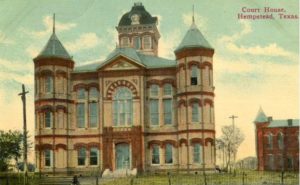Hempstead History: Intriguing Stories of an Interesting Town

November 10 marks an important date in Hempstead history: It’s when we first became an incorporated town. And while such a momentous event deserves to be recognized, we’ll be the first to admit it was just the start of it all. The truth is, when we say there’s somethin’ to be said about Hempstead, that includes our town’s intriguing past.
In honor of that big November 10, 1858, anniversary, we’ve decided to pull together a few of our favorite bits of Hempstead history from the Waller County Historical Survey Committee’s “A History of Waller County, Texas”. Sit back, read on and prepare to learn a little somethin’. Because our little town has one great story.
Hempstead, Texas: The Town That Was, Then Wasn’t — Then Was, Again
It was 1858 when the town of Hempstead was first incorporated, but funny enough, that time wasn’t the last. We were incorporated as the City of Hempstead in 1871, and it was decided the city would be overseen by a mayor and aldermen (basically a city council). Things continued as usual until February of 1899 when, by a vote of 268 to 43, citizens voted to end that corporation. Although attempts were made to get the city reincorporated during the 1928, 1930 and 1933 election cycles, the measure didn’t pass until 1935. Things became official (again) with the announcement of “The Incorporated Town of Hempstead” on June 10, 1935, and we’ve remained that way ever since.
Early Hempstead Settlers Had Their Own Way of Goin’ About Things
It takes a little time for a town to get all its infrastructure in place, and to truly find its footing. And history tells us Hempstead, Texas, got a bit creative. It’s said the first public school open to our children was set up inside an old jail. Meanwhile, since details hadn’t yet been hammered out regarding law enforcement, local men took to wearing six-shooters, earning the town of Hempstead the nickname “Six Shooter Junction.” We’ve come a long way since then, but it’s fascinating to think back to what we once were.
Rail Lines Played a Key Role in Keeping Growth Chugging Forward
Hempstead, Texas, was thriving before we ever became an official town, thanks in large part to the rail line that ran through it. With the rail line came railroad shops, local jobs and the like. In the 1860s, during the Civil War, that proximity to the rail lines made the town a popular spot for military personnel looking to gather their troops. Nearby camps included Camp Carter, Camp Hebert and Camp Groce, where Major General George A. Custer was stationed. As time progressed and railroad business died down some, transportation options remained important to Hempstead. Our location’s proximity to major thoroughfares, regional airports and, yes, rail service, too, allow for easy interstate commerce (and big business opportunity) to this day.
There’s no denying Hempstead history is pretty interesting stuff — and there’s a whole lot more where that came from. (We haven’t even touched on our wonderful watermelons!) As Hempstead, TX, continues to grow and welcome new businesses and residents in, we’re bound to add more great stories to the list. By the way, if you’re interested in helping opportunity take root and seeing Hempstead grow, consider becoming a member of the Hempstead Commerce & Civic Association (HCCA). We’d love to have you!
Share This Post with Your Friends

